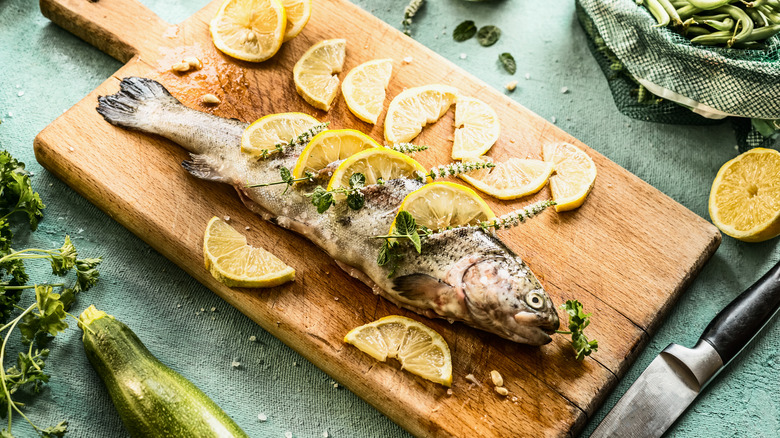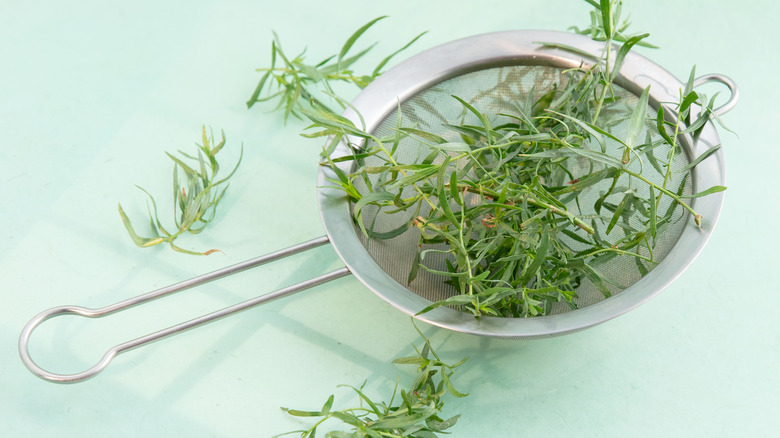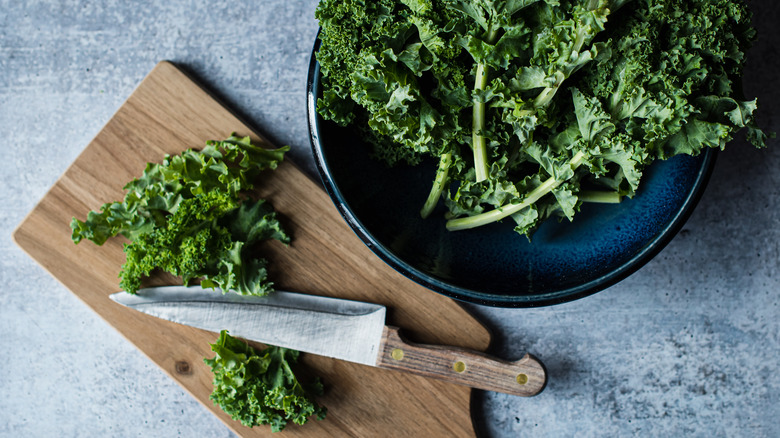11 Genius Ways To Disguise Fishy Tastes In Seafood
Chef Terri Dien, culinary expert and the author of "The Big 10 Fish & Seafood Cookbook" and "Essential Seafood Cookbook," has a preference toward using only fresh seafood. "Fresh fish shouldn't have a very strong odor. It should smell like the seawater (or lakewater) from which it was caught," says Dien. However, most of us don't have the luxury of catching our fish right before cooking, so we often turn to grocery stores or fish markets. Unfortunately, these sources sometimes deliver fish with a more pronounced, fishy flavor and smell, which can be off-putting.
Understanding the root of this strong flavor is key. According to Chef Barton Seaver, author of "The Joy of Seafood," "Two If By Sea," and other seafood cookbooks, "Fat equals flavor. That's true in beef. It's true in pork, it's true in much cooking. So what you're tasting in robustly flavored fish is a higher fat content." While some people love this deep, rich flavor, others find it overpowering. The good news is that there are many ways to tone down that strong "fishy" taste in any fish. Whether you're a seafood lover looking to soften the flavor of your favorite dish or someone hesitant to cook fish at home due to its strong flavor and odor, these 11 tips will help you prepare seafood that's flavorful, balanced, and appealing to even the most sensitive of palates. You'll be ready to confidently make a seafood meal in no time.
Slow cook on low heat
Cooking fish at high temperatures can create a strong, lingering fishy aroma that many find unpleasant. Chef Barton Seaver explains that when fish is cooked at high heat, "fat and moisture exude from the fish, hit a hot pan or grease, vaporize, and then go up into the air," releasing a powerful smell. This isn't just about odor — it directly impacts the taste of the fish. This is because the way something smells has a huge impact on the way it tastes. When fish is cooked at high heat, the strong smell intensifies the fishy flavor, which can be off-putting.
One effective way to counteract this is by slow-cooking your fish at a lower temperature. This method reduces the release of strong odors and, in turn, the intense flavor. With slow roasting on low heat, "you're just not creating particulates that enter the air will then give you the smell that we're trying to avoid," says Seaver. "In my kitchen, I use my toaster oven to cook most of my fish. It's easy, convenient, and quick, but it's also very low-stress." Alternatively, poaching your fish on the stovetop offers a similar benefit, maintaining moisture while preventing overpowering aromas. By slow-cooking your fish, you not only control the smell but also enhance the overall texture and taste, making it a win-win approach for anyone looking to enjoy seafood without the strong fishy flavor.
Cook with shallots
When it comes to balancing the flavors in seafood, shallots are one of the ingredients can be your best friend. Their subtle sweetness and mild oniony flavor can add a layer of complexity to your dish without necessarily overwhelming the taste of the fish. Barton Seaver incorporates shallots into his seafood recipes all the time. "I will often do a sauce with some finely diced shallots, something to add even a hint of texture, just a little bit of crunch, and that provides succulence and contrast," he shares.
The beauty of shallots lies in their versatility. They can be sautéed to bring out their natural sweetness or used raw for a sharper bite, depending on the needs of your dish. When cooked, they soften and caramelize, adding a mellow depth that pairs perfectly with fish. This can help to mask any lingering fishiness, making the overall dish more appealing to those who shy away from stronger seafood flavors. In addition to their flavor, shallots also contribute to the dish's aroma, creating a more inviting scent that can counterbalance the fishy smell. The combination of shallots with other ingredients like herbs, butter, or wine can create a complex, rich sauce that elevates the fish without overshadowing it. Even if they are not your preferred additional ingredient, trying them out with seafood may give you a fresh take.
Use vinegar
Vinegar is a culinary essential when it comes to taming strong flavors, and fish is no exception. The acidity of vinegar not only brightens up dishes but also has the ability to neutralize the fishy smell and taste that not everyone loves. "The smell associated with fish comes from their physiology," Terri Dien explains. "Fish use certain amino acids to help balance salt levels in their cells. When the fish are killed, bacteria and enzymes convert the amino acids to another compound that gives off that 'fishy' odor." This is where vinegar comes into play. According to Dien, vinegar, being an acidic ingredient, works by making the compounds in the fish "bind with water instead of the amino acids and thereby become less volatile." This reduces the intensity of the flavor, making the fish more palatable. Whether you choose to marinate the fish in vinegar before cooking or incorporate it into a sauce, the result is a dish with a more balanced, less overwhelming flavor.
Incorporating vinegar into your cooking doesn't mean your dish will taste sour. On the contrary, the acidity can help highlight the fish's natural flavors while keeping the fishiness in check. You can use different types of vinegar depending on the dish — white wine vinegar for a delicate, subtle flavor, balsamic for a richer, sweeter touch, or rice vinegar for an Asian-inspired twist. Whatever you choose, it's a great way to neutralize the fishiness in your seafood.
Add lemon
Lemon is a well-known companion to seafood for good reason. Its bright acidity cuts through the richness of fish, bringing a refreshing balance to the dish. Barton Seaver points out that the higher the fat content of the fish, the more "fishy" it will taste. "Acidic components are what tame fat, what brings it into balance and create some punctuation." This is exactly why lemon works so well with seafood. The acidity of lemon juice not only balances the fat but also helps to neutralize the pungent taste. Plus, when lemon juice is applied to fish, it begins to "cook" the fish slightly, breaking down proteins and mitigating the stronger flavors. This makes the overall taste notably lighter, which may be helpful if you're still adjusting to the taste of seafood.
It's not just the juice of a lemon that's useful, either. Lemon zest can also add a burst of fresh, citrusy flavor without adding extra acidity. Terri Dien says one of her favorite marinades is "lemon juice and zest, thyme, olive oil, and a small dollop of mustard for a classic, French flavor." This combination tames the fishiness and enhances the natural flavors of the seafood at the same time, creating a dish that's both balanced and vibrant. Plus, there are plenty of tasty lemony fish recipes out there, so no need to stress about how to incorporate lemon into your seafood all on your own.
Marinate with tomato
Tomatoes are more than just a salad ingredient. As you might not already know, they're also a secret weapon in minimizing the fishy taste of seafood. The acidity in tomatoes, much like that in lemons and vinegar, helps to break down the compounds responsible for the strong odor and taste that some find unpleasant. As Terri Dien explains, marinating the fish in acidic-based marinades like tomato helps minimize fishiness. This process not only enhances the flavor but also softens the texture of the fish by loosening the fish's muscle fibers, making it more tender and delicious.
A tomato-based marinade can be as simple or complex as you like. Terri Dean is a big fan of this approach, and notes that marinades can help complement different cuisines. "I'll marinate my fish with lemon zest, cherry tomatoes, and kalamata olives (and a bit of its brine) with chopped parsley." Another idea could be combining chopped tomatoes with olive oil, garlic, and basil. Whatever tomato-based marinade you choose, make sure to let the fish sit in it for at least 30 minutes before cooking to allow the flavors to meld and the acidity to work its magic. The result is a dish with a more neutral, less fishy flavor profile.
Add tarragon
Tarragon flies under the radar in many kitchens, but when it comes to disguising fishy flavors in some seafood, it's a good herb to have around. Barton Seaver specifically praises herbs with "high, piercing aromatics," like tarragon to use when cooking seafood. Tarragon has a distinctive blend of licorice and sweet fennel flavors, so it makes sense that it's so effective. This is especially true when you're working with richer, fattier fish like salmon or mackerel, where the natural oils can sometimes be overwhelming. This is where tarragon steps in, slicing through the richness and bringing a fresh, sharp note that brightens the overall flavor profile.
Tarragon's versatility also makes it an excellent addition to various seafood preparations. In a delicate sauce or a creamy marinade, tarragon can easily add to a dish's depth while complementing the natural flavor of the seafood. What's more, tarragon's subtle sweetness can help balance out acidic ingredients that you might also include, creating a more harmonious dining experience. If you like oregano, tarragon is also a noted substitute for the basil whenever necessary — just keep in mind that it has a more robust flavor, meaning you would use less tarragon than you would basil.
Add chervil
Chervil is an herb in the parsley family known for its fine, feathery leaves. It's one of the classic ingredients in the French herb blend, fines herbes. You see much more chervil in French cooking than in American cooking, but according to Barton Seaver, it's a hidden gem, especially when it comes to seafood. Seaver describes chervil as a "soft, tender herb that has an elegant flavor," making it the perfect choice for those looking to tame a strong, fishy taste. Despite its delicate nature, chervil has a subtle sweetness and a faint hint of anise, which can pair beautifully with the flavors of fish of many types of fish.
Another reason why chervil deserves more attention is how easy it is to adapt to different flavor profiles. Whether you're making a light fish soup, a seafood salad, or a simple grilled fillet, adding chervil can bring a new dimension to the dish. Its tender leaves are best used fresh, either sprinkled over the finished dish or stirred in at the last moment to preserve their delicate flavor. If you're looking to experiment with new flavors in your seafood dishes to mask a fishy flavor, chervil is an excellent herb to start with.
Add mint
Mint might not be the first herb that comes to mind when cooking seafood, but it's an incredibly effective way to enhance and neutralize the flavors of fish. Barton Seaver highlights mint as a flavor that "acts much like acid in that it accentuates the inherent flavors of whatever it's paired with. So just a few sprigs of mint, the leaves torn into small pieces and scattered atop just before serving, and you end up with this wonderful aroma that pairs so beautifully with the flavors of seafood." This makes mint a surprisingly ideal ingredient in lots of seafood dishes. The cool, refreshing notes of mint can even cut through the richness of fatty fish, much like a squeeze of lemon would, adding brightness and a dimension of complexity.
Per Seaver's suggestion, you can simply tear a few fresh leaves and toss them over a seafood dish just before serving. Alternatively, you might add it to a sauce or marinade, where its cooling and aromatic qualities can penetrate the dish more deeply and add a nice contrast. Mint pairs particularly well with Mediterranean-inspired dishes, where it can invigorate the flavors of ingredients like lemon, garlic, and olive oil. It can also be easily added to a delicious seafood salad to provide a burst of flavor that complements the other ingredients perfectly.
Include a creamy element
Incorporating a creamy element into seafood dishes can make all the difference when trying to mask a powerful flavor. Barton Seaver advises that "anything creamy tends to be good, as it rises to the level of the fish." Creaminess has a way of toning down the fishy taste of seafood, creating a more well-rounded dish. However, Seaver also cautions, "You don't want to overdo it in terms of fat on fat." The key is to find the right balance, where the creaminess enhances rather than overwhelms and drowns out the fish.
One excellent way to introduce a creamy element is through a risotto. "The creaminess, the starchiness of that rice, that's a really great way to temper the robust flavor of seafood," says Seaver. While a creamy risotto is great with any seafood dish, it can work especially well with bolder, fattier fish when it comes to hiding flavor fishiness. Another approach is to incorporate ingredients like coconut milk, which Terri Dien recommends for marinating Asian-inspired seafood dishes. She especially likes the combination of lime juice and zest, fresh chiles, cilantro, and coconut milk. Ultimately, the right creamy addition can transform your seafood meal into a less pungent experience, making it more enjoyable for those sensitive to strong fish flavors.
Include a smoky element
Introducing a smoky element to seafood dishes is another very effective way to balance strong fish flavors. It makes sense then that smoked fish is so popular. Barton Seaver explains that fatty fish are really well-paired with smoke. "That's why we smoke mackerel, we smoke trout, we smoke salmon," Seaver elaborates. The smokiness adds depth and complexity to the fish, mellowing out its rich flavors and creating a more layered taste experience. However, you don't have to limit yourself to smoking the fish itself, which is often a tedious and time-consuming process involving specialized equipment. Seaver suggests that you can also add anything smoky, "like smoked sweet paprika," to achieve a similar effect.
There are many ways to introduce smokiness into your seafood dishes aside from smoked paprika, too. You can use other smoked spices like chipotle or cumin, add a few drops of liquid smoke to a marinade, or even lightly grill the fish to impart a smoky flavor. This way, you can get that delicious smoky flavor without the hassle of smoking the fish from scratch. Each method brings its own unique touch, allowing you to experiment and find the perfect smoke enhancement for different seafood dishes.
Remove the skin
The natural oils in fish skin are often responsible for contributing to a fishy taste, which can steer people away from enjoying fish altogether. As Terri Dien points out, "Really oily fish like salmon or mackerel might smell stronger than white-fleshed fish like tilapia and cod." If you want to reduce the fishiness of white-fleshed fish, you can remove its skin before beginning to cook it. Removing the skin is a simple but effective way to minimize the strong flavors that can come from these oils.
Barton Seaver also notes that "the skin, if present on a piece of fish, whether slow-roasted or poached, is going to be soft. It's going to be gelatinous with a mouth-coating texture to it. That might not be for everybody," he says. So, by removing the skin, you not only reduce the fishy taste but also avoid the unappealing texture that plenty of people find difficult to enjoy.











